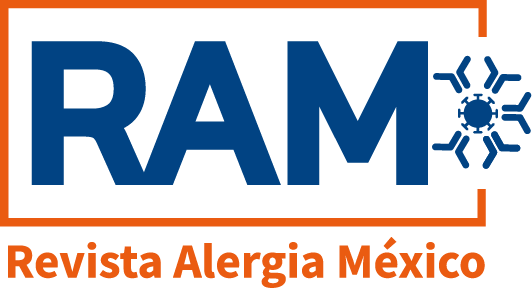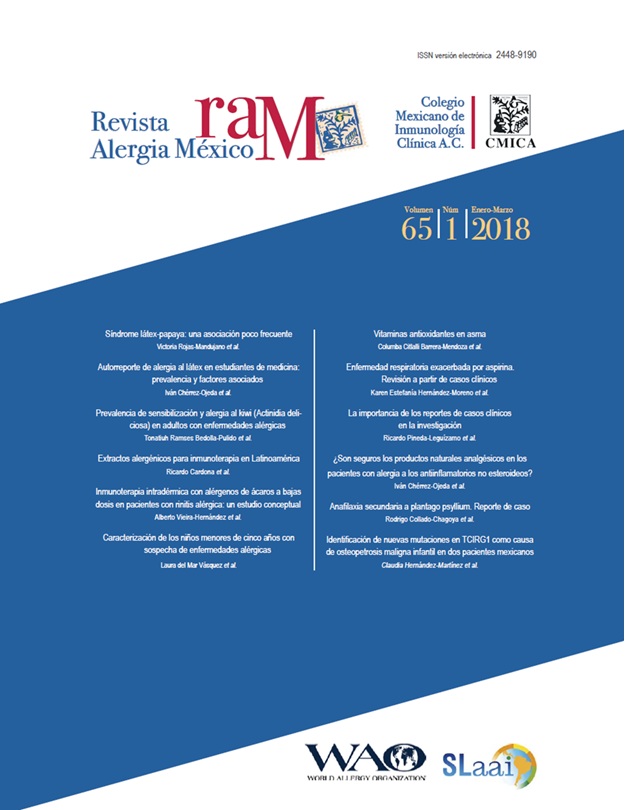Resumen
Antecedentes: Los síntomas de enfermedad alérgica constituyen una causa frecuente de consulta en la infancia.
Objetivo: Describir el perfil de una población de preescolares colombianos atendidos en un servicio de alergología y evaluar los posibles factores de riesgo.
Métodos: Estudio descriptivo trasversal de pacientes menores de cinco años evaluados durante un año. Se realizó historia clínica completa y estudio alergológico con pruebas cutáneas según el caso. Se analizaron factores de riesgo mediante análisis multivariado.
Resultados: Se incluyeron 674 pacientes, 382 (52.7 %) hombres. La mediana de edad fue 34 meses. Los motivos de consulta fueron tos o sibilancias recurrentes (54.3 %), rinitis (48.7 %) y eccema (32.2 %). Se realizaron pruebas cutáneas con aeroalérgenos a 299 pacientes (48 %) y con alimentos a 170 (27 %), encontrando positividad en 114 (38 %) y 16 (9.4 %), respectivamente. Los principales sensibilizadores fueron los ácaros y el huevo. Se encontró asociación directa entre eccema y prematurez (OR = 0.496; IC 95 % = 0.289-0.823), tos/sibilancias recurrentes e historia familiar de alergia (OR = 1.837; IC 95 % = 1.306-2.586), y tos/sibilancias recurrentes y antecedente de bronquiolitis (OR = 2.646; IC 95 % = 1.812-3.886).
Conclusión: Los síntomas respiratorios representaron la principal causa de consulta. Los ácaros fueron los alérgenos más identificados. La historia familiar de alergia y la bronquiolitis parecen ser factores de riesgo.Referencias
Asher MI, Montefort S, Björkstén B, Lai CK, Strachan DP, Weiland SK, et al. Worldwide time trends in the prevalence of symptoms of asthma, allergic rhino-conjunctivitis, and eczema in childhood: ISAAC Phases One and Three repeat multicountry cross-sectional surveys. Lancet. 2006;368(9537):733-743. DOI: 10.1016/S0140-6736(06)69283-0
Morgan WJ, Stern DA, Sherrill DL, Guerra S, Holberg CJ, Guilbert TW, et al. Outcome of asthma and wheezing in the first 6 years of life: Follow-up through adolescence. Am J Respir Crit Care Med. 2005;172(10):1253-1258. DOI: 10.1164/rccm.200504-525OC
Illi S, Von-Mutius E, Lau S, Nickel R, Grüber C, Niggemann B, et al. The natural course of atopic dermatitis from birth to age 7 years and the association with asthma. J Allergy Clin Immunol. 2004;113(5):925-931. DOI: 10.1016/j.jaci.2004.01.778
Arévalo-Herrera M, Reyes MA, Victoria L, Villegas A, Badiel M, Herrera S. As-ma y rinitis alérgica en preescolares en Cali. Colomb Med. 2003;34(1):4-8. Dis-ponible en: http://colombiamedica.univalle.edu.co/index.php/comedica/article/view/246/249
Bousquet J, Heinzerling L, Bachert C, Papadopoulos NG, Bousquet PJ, Burney PG, et al. Practical guide to skin prick tests in allergy to aeroallergens. Allergy. 2012;67(1):18-24. DOI: 10.1111/j.1398-9995.2011.02728.x
Mallol J, Crane J, Von-Mutius E, Odhiambo J, Keil U, Stewart A, et al. The In-ternational Study of Asthma and Allergies in Childhood (ISAAC) Phase Three: A global synthesis. Allergol Immunopathol (Madr). 2013;41(2):73-85. DOI: 10.1016/j.aller.2012.03.001
Dennis RJ, Caraballo L, García E, Rojas MX, Rondon MA, Pérez A, et al. Prevalence of asthma and other allergic conditions in Colombia 2009–2010: a cross-sectional study. BMC Pulm Med. 2012;12:17. DOI: 10.1186/1471-2466-12-17
Martinez FD, Wright AL, Taussig LM, Holberg CJ, Halonen M, Morgan WJ. Asthma and wheezing in the first six years of life. The Group Health Medical As-sociates. N Engl J Med. 1995;3323):133-138. DOI: 10.1056/NEJM199501193320301
Taussig LM, Wright AL, Holberg CJ, Halonen M, Morgan WJ, Martinez FD. Tuc-son Children’s Respiratory Study: 1980 to present. J Allergy Clin Immunol. 2003;111(4):661-675. DOI: 10.1067/mai.2003.162
Kurukulaaratchy RJ, Karmaus W, Arshad SH. Sex and atopy influences on the natural history of rhinitis. Curr Opin Allergy Clin Immunol. 2012;12(1):7-12. DOI: 10.1097/ACI.0b013e32834ecc4e
Kelly C, Gangur V. Sex disparity in food allergy: Evidence from the PubMed da-tabase. J Allergy (Cairo). 2009;2009:159845. DOI: 10.1155/2009/159845
Ziyab AH, Raza A, Karmaus W, Tongue N, Zhang H, Matthews S, et al. Trends in eczema in the first 18 years of life: Results from the Isle of Wight 1989 birth cohort study. Clin Exp Allergy. 2010;40(12):1776-1784. DOI: 10.1111/j.1365-2222.2010.03633.x
Ortega-López MC, De-La-Hoz JA, León DA, Parra JC. Prevalencia de sensibili-zación en pacientes pediátricos con sospecha o diagnóstico de enfermedad alérgica. Estudio PRESPPENAL. Rev Med. 2014;36(3):234-246. Disponible en: http://revistamedicina.net/ojsanm/index.php/Medicina/article/view/106-4
Sears MR, Greene JM, Willan AR, Taylor DR, Flannery EM, Cowan JO, et al. Long-term relation between breastfeeding and development of atopy and asth-ma in children and young adults: A longitudinal study. Lancet. 2002;360(9337): 901-907. DOI: 10.1016/S0140-6736(02)11025-7
Saarinen UM, Kajosaari M. Breastfeeding as prophylaxis against atopic disease. Prospective follow-up study until 17 years old. Lancet. 1995;346(8982):1065-1069.
Negele K, Heinrich J, Borte M, Von-Berg A, Schaaf B, Lehmann I, et al. Mode of delivery and development of atopic disease during the first two years of life. Pe-diatr Allergy Immunol. 2004;15(1):48-54. DOI: 10.1046/j.0905-6157.2003.00101.x
Haataja P, Korhonen P, Ojala R, Hirvonen M, Paassilta M, Gissler M, et al. Asthma and atopic dermatitis in children born moderately and late preterm. Eur J Pediatr. 2016;175(6):799-780. DOI: 10.1007/s00431-016-2708-8
Ardura-García C, Vaca M, Oviedo G, Sandoval C, Workman L, Schuyler AJ, et al. Risk factors for acute asthma in tropical America: A case-control study in the City of Esmeraldas, Ecuador. Pediatr Allergy Immunol. 2015;26(5):423-430. DOI: 10.1111/pai.12401
Beigelman A, Bacharier LB. The role of early life viral bronchiolitis in the incep-tion of asthma. Curr Opin Allergy Clin Immunol. 2013;13(2):211-216. DOI: 10.1097/ACI.0b013e32835eb6ef
Burke W, Fesinmeyer M, Reed K, Hampson L, Carlsten C. Family history as predictor of asthma risk. Am J Prev Med. 2003;24(2):160-169. DOI: 10.1016/S0749-3797(02)00589-5
O'Connor GT, Lynch SV, Bloomberg GR, Kattan M, Wood RA, Gergen PJ, et al. Early-life home environment and risk of asthma among inner-city children. J Allergy Clin Immunol. 2017;S0091-6749(17):31204-31206. DOI: 10.1016/j.jaci.2017.06.040
Hu LW, Yang M, Chen S, Shah K, Hailegiorgis Y, Burgens R, et al. Effects of in utero and Postnatal Exposure to Secondhand Smoke on Lung Function by Gen-der and Asthma Status: The Seven Northeastern Cities (SNEC) study. Respira-tion. 2017;93(3):189-197. DOI: 10.1159/000455140
Leal F, García E, Fiorentino S, Gómez E. Sensibilización alérgica a los alimen-tos tropicales usados en la ablactación. Actualizaciones Pediatr. 1991;1:3-5.

Esta obra está bajo una licencia internacional Creative Commons Atribución-NoComercial 4.0.
Derechos de autor 2018 Revista Alergia México





